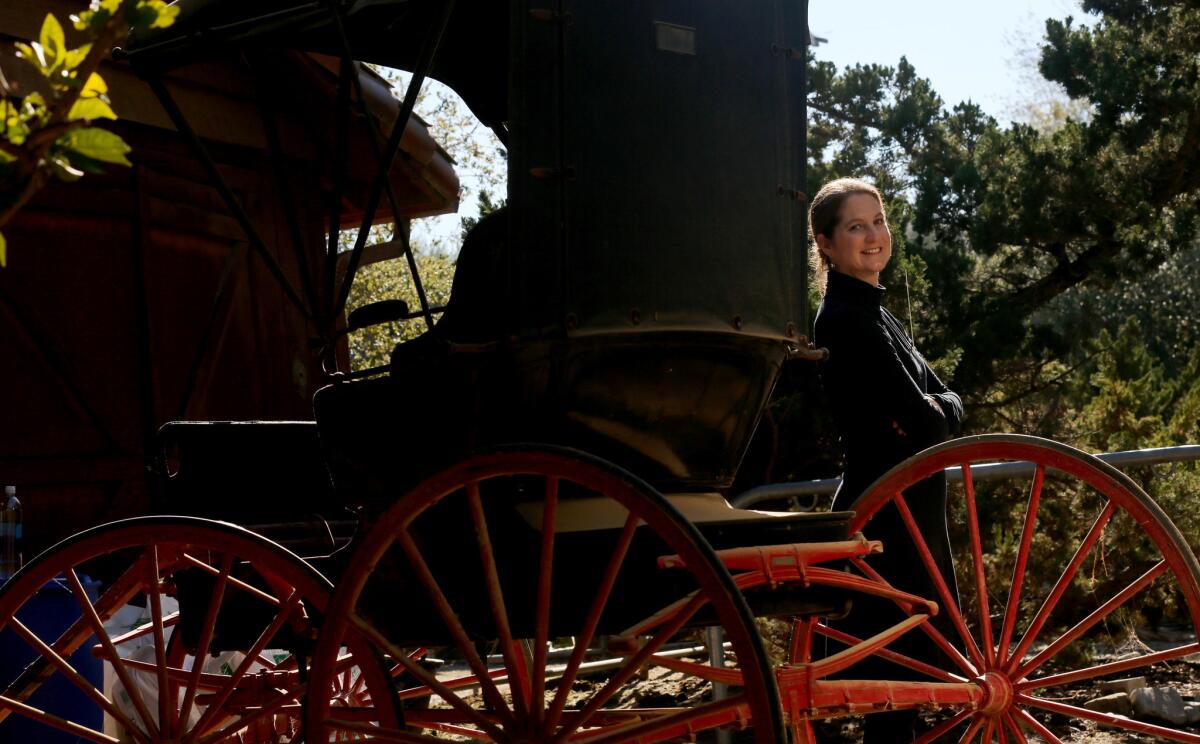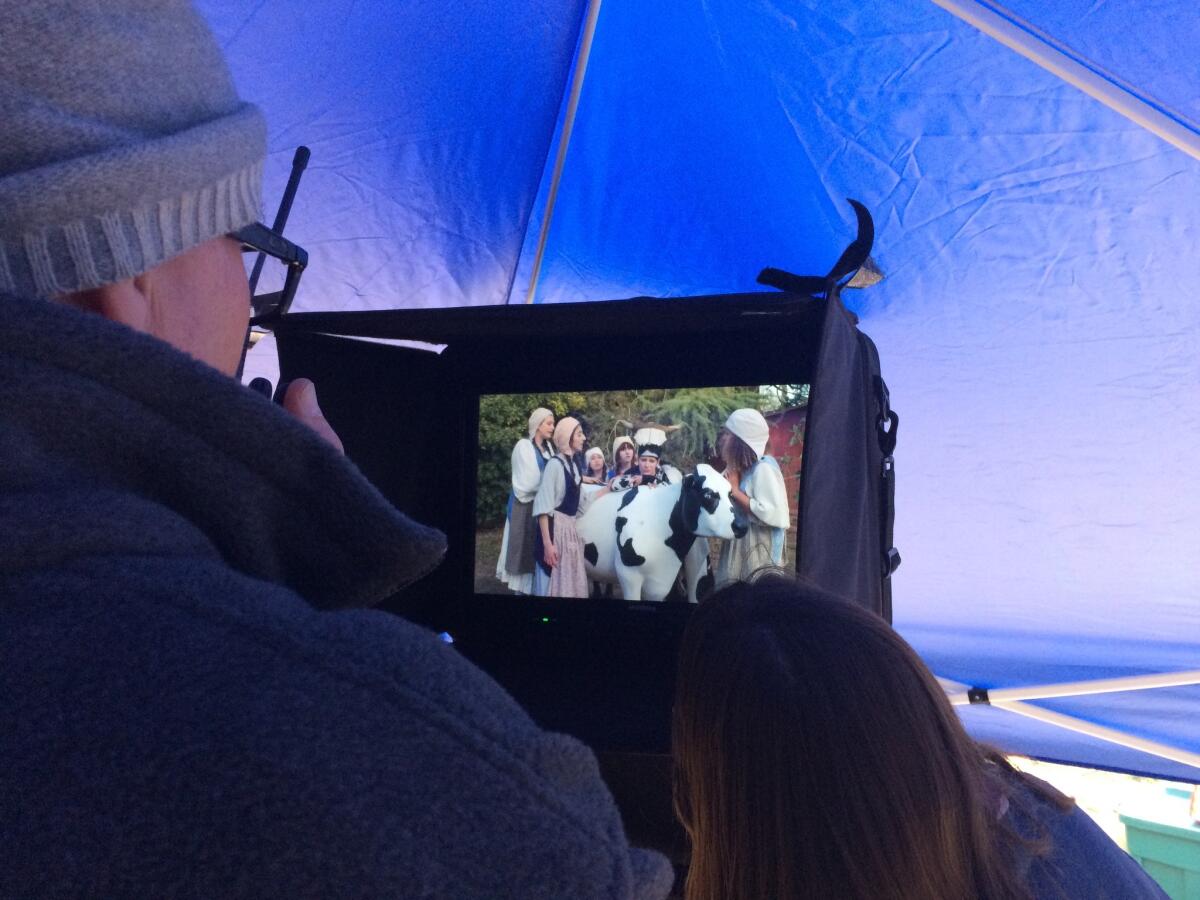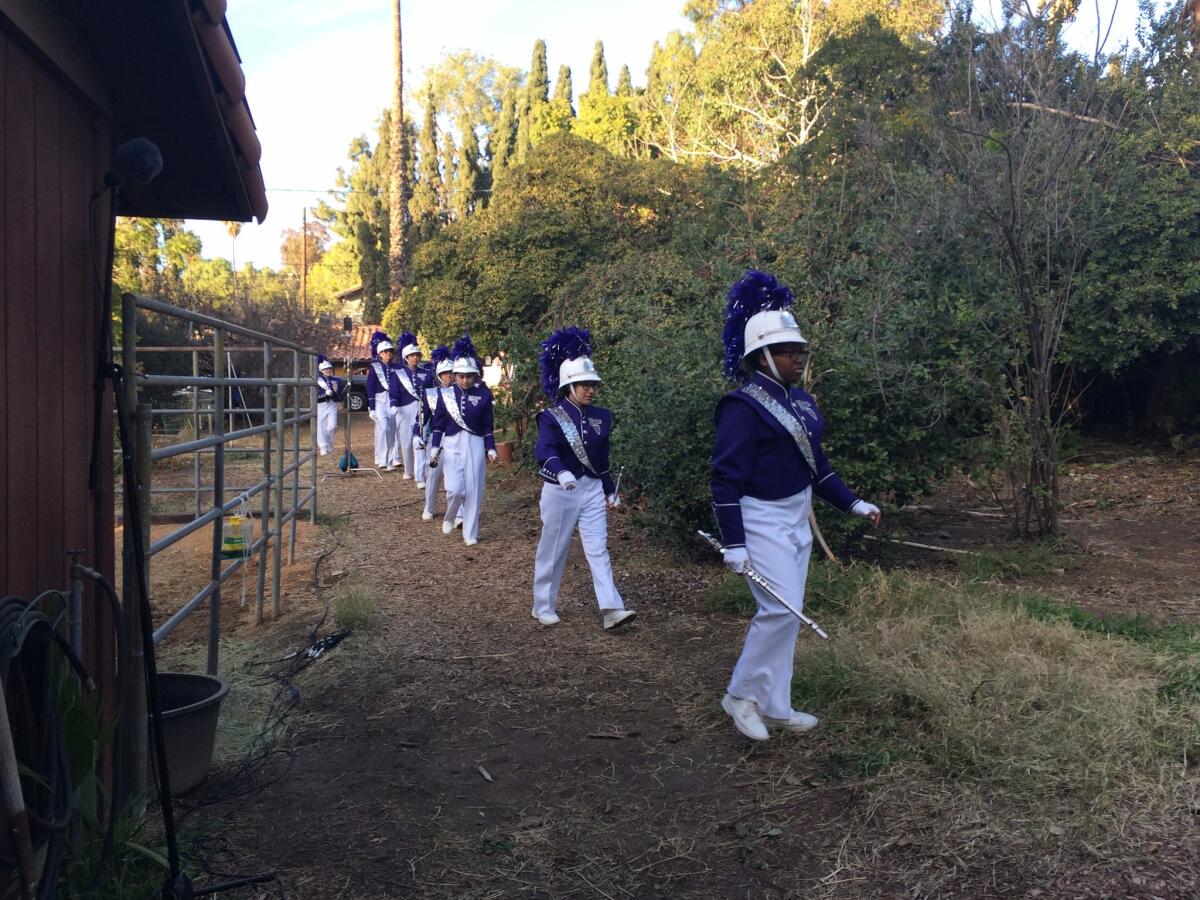How Southern California became the backdrop to an opera about a ‘hysterical’ woman

- Share via
Dusk is enveloping a small Shadow Hills ranch in steely gray light as a dying cow sings an aria. A chorus of milkmaids and a marching band lead the ill-fated bovine to her untimely death. In the background, a pair of alpacas watch the scene with puzzled curiosity.
This is not a hallucination. It is an opera — a highly unusual one.
Conceived by New York-based composer Lisa Bielawa, “Vireo: The Spiritual Biography of a Witch’s Accuser” tells the story of Vireo, a troubled young woman experiencing hysterical fits — in the form of strange visions and voices — and the chain of events that this condition unleashes around her. It’s a plum role for a female singer, but its innovation also lies in its format: “Vireo” is an episodic opera designed to be watched online in roughly 10-minute episodes — or in a single marathon binge, when the entire opera goes online in spring 2017.
“I like the mashing of skills,” says Bielawa of how the production fuses cinema and live performance with the micro-chapter quality that is typical of the Internet. “I want this to promote collaboration between different forms.”
To be certain, this is no simple simulcast. Though the performances are all captured live (there is no dubbing), the final product is designed specifically to be seen like a movie.
“I didn’t want it to be some three-camera shoot with performers on stage — I wanted this to be a film,” says director Charles Otte, who has directed “La Belle et la Bête” for composer Philip Glass, among other theater works. “It’s a chance to go inside the performance. It’s a great sense of the long line, a sense of a performance as it continues.”
In keeping with episodic nature of the production, the opera is being shot in different locations around Southern California.
The first two were filmed in Santa Ana at the Yost Theater, a historic vaudeville performance house from 1912. “It’s got that warm wood,” Bielawa says. “It feels so great to sing there.”
One episode is set at a ranch in Shadow Hills; others at the Actors’ Gang theater in Culver City. On May 15, the team will film at an old warehouse-turned-soundstage in Boyle Heights during a free performance to which the public is invited. The crew also plans later shoots in New York and in San Francisco inside the former federal prison at Alcatraz.
“It’s so iconic,” says Bielawa of Alcatraz. “It’s Episode 9 — about two-thirds of the way through the story. Vireo gets thrown in jail and she sings this incredible aria. It’s the soul of the opera.”
Staging the performances presents a mind-boggling number of challenges. On the day of the dying cow shoot, Otte and Bielawa manage an epic nine-minute take that involves various indoor and outdoor locations, multiple groups of singers (including members of the San Francisco Girls Chorus) and a high school marching band from Indio.
“There’s a massive potential for disaster,” says Otte. “But somehow we all know we are going to pull it off.”
And somehow they do. I stand behind the director for the final take of the day, as the camera frames Vireo and her mother. In the soft light, the women take on the aspect of a painting by Vermeer.

For Bielawa, “Vireo” is one more experimental work in a career that has been defined by them. A longtime vocalist with the Philip Glass Ensemble, the San Francisco-born artist has also drawn notice (including a prestigious Rome Prize) for her unique compositions.
In 2010, she presented a series called “Chance Encounter,” in which she wrote operas based on conversations she overheard in public places in various cities. She would then return to those sites with performers to stage 35-minute public operas based on those chats.
Three years later, she created a piece called “Airfield Broadcast,” which involved hundreds of musicians playing a composition as they roamed around the Tempelhof airfield in Germany.
“Vireo,” however, is more than just another project. It is a long-running passion that goes back more than 20 years to Bielawa’s undergraduate days at Yale University.
“The story line, it’s very tragically beautiful,” says Rowen Sabala, a composed 17-year-old from Anaheim and a senior at the Orange County School of the Arts who plays the role of Vireo. “This young girl, she’s lost. She doesn’t know what to do. She’s sad, she sees things, she hears things. You could almost see it as schizophrenia in a way.”
The story in “Vireo” bounces among various time periods, from the contemporary era to the Dark Ages, from 19th century France to the early 20th century. It was during that latter period that Surrealist artists became intrigued by young women who experienced symptoms of hysteria, since they believed it represented a profound connection to the unconscious.
The scene involving the dying cow captures a moment in the opera in which Vireo has been hearing voices and the cows are dying. The community around her believes that these tragedies must be the result of a witch. Yet even after the suspected local witch is dispatched, Vireo continues to hear voices and the cows continue to fall.
Cue alto Kirsten Sollek singing mournfully in a cow cape while holding a tray of ground beef. It may sound absurd, but the cow’s moving aria, combined with the haunting chorus of the milkmaids, becomes a dream-like portrait of death.
My terror index has gone down steadily. But you don’t want it to go too far. I like to operate at the limits of my skill set.
— Lisa Bielawa, composer
As a junior at Yale, Bielawa became intrigued by the topic of hysteria because of the connections it bore to gender.
“Time and again, it was women who were experiencing the fits,” she explains. “And I discovered that it was always these groups of male writers who were writing about it. ... The thing that intrigued me was that the voices of the girls was often missing.”
Bielawa isn’t interested in the underlying scientific causes of what may have once been labeled hysteria. “I couldn’t answer that,” she says. What she is struck by is what the condition signified culturally — at once something that could upend a young woman’s life, but also give her a modicum of power.
“These girls, the ones who exhibited these behaviors, were rerouted for life,” she explains. “They were put in hospitals and pulled out of family life. But it actually enabled them to speak to intelligent men all day who were interested in their lives. It was a setting where their ideas and experiences were the focus of the day.
“This type of possession was also socially contagious. Isn’t that interesting?”
The composer, who spent her senior year at Yale investigating the cultural ramifications of this phenomenon, considered it rich material for a work of art. And thus “Vireo” was born — as a traditional three-act opera — sometime in the 1990s. She tapped a friend and colleague, playwright Erik Ehn, the former head of the theater program at California Institute of the Arts to write the libretto. (Ehn is known for an ongoing series called “The Saint Plays,” inspired by the lives of the saints.)
“We both wrote ferociously in the early goings,” he recalls in a telephone interview from Rhode Island, where he lives and teaches. “We thought we were all ready to go. But a performance is like founding a city. So many people are involved. And we had to get a city together before the opera could come into being.”
“I must have sent it to every opera company in the U.S. — and this was before email,” says Bielawa. “Nobody would take it seriously.”

But a residency that began at the Grand Central Art Center, or GCAC, in Santa Ana in 2012 brought the project back to life.
The center, which is operated by Cal State Fullerton, is known for its experimental approach to its residencies — allowing artists to arrive in Orange County without a preconceived project in mind. The idea is that time and the setting can inspire something unique.
“We are not agenda driven,” says GCAC director John Spiak. “It’s about realizing an artist’s creative vision.”
To that end, Spiak took Bielawa to a number of sites around the county that might motivate a performance of one kind or another. They toured the former Marine Corps Air Station at El Toro and walked along the Santa Ana River. They also explored the Yost Theater.
As part of Bielawa’s get-to-know-Southern-California efforts, Spiak casually suggested that she watch the comedy series “Arrested Development,” since the show was set in (and lampooned) Orange County. Interestingly, it was the adventures of the fictional Bluth family and their charmingly unscrupulous patriarch that inspired Bielawa to write a new kind of opera.
“I realized that Southern California is where serial television is made,” she explains. “So what if I do an opera where the Kronos Quartet shows up for an episode? Or a high school marching band?”
And thus “Vireo” was reborn as a series, with KCET on board to broadcast the episodes on-air and online.
Ultimately, “Vireo” will consist of a dozen 10-minute episodes that come together to tell the story of a troubled and confused young woman. Though the production is not complete, it has already picked up an award from the American Society of Composers, Authors and Publishers, which honored the work for its innovations in multimedia last fall.
Like other experimental operas — such as Yuval Sharon’s “Hopscotch,” which was performed in locations around L.A., including moving cars — the entire process behind “Vireo” has upended the way operas are typically produced.
Bielawa is still in the process of composing some of the music — evolving the work as she becomes increasingly familiar with Sabala’s voice. “Rowen is growing so I can write for her as she sings the role, I can grow with her,” says Bielawa. “What other composer gets to do something like that?”
In the process, the team has had to find ways to improvise on slim budgets. (Each episode has cost between $25,000 and $50,000 to shoot.) The props are simple. The Shadow Hills ranch set was the home of the opera’s costume designer. When the San Francisco Girls Chorus had to come to Southern California for a shoot, the GCAC arranged homestays.
“I don’t know how we even did it,” says Spiak. “Five of them stayed at my house.”
They partially did it with the assistance of grants from the Warhol Foundation and the MAP Fund (the latter of which came in this month), among others.
The Grand Central Art Center has never produced an opera, but Spiak says that didn’t stop him from signing on to the idea: “When Lisa said, ‘Let’s do “Vireo,” ’ we said, ‘How can we do this?’ And we started putting feelers out to the local art schools.”
Bielawa says that she’s had moments since the project launched last year in which she’s wondered if everything would fall into place. But she says those moments are increasingly behind her.
“My terror index has gone down steadily,” she says. “But you don’t want it to go too far. I like to operate at the limits of my skill set.”
That’s been one of the big benefits of working with so many teenagers, she says. They are ready and willing to take risks, to do things that haven’t been tried.
“Young people, they don’t know it’s complicated,” she marvels. “No one told them.”
Episode 7 of “Vireo” will tape on May 15 at 4:30 p.m. at 653 S. Anderson St. in Boyle Heights. Tickets are free but seating is limited and an RSVP is required at operavireo.org. For release dates and other news, logon to KCET.org.
Find me on Twitter @cmonstah.
More to Read
The biggest entertainment stories
Get our big stories about Hollywood, film, television, music, arts, culture and more right in your inbox as soon as they publish.
You may occasionally receive promotional content from the Los Angeles Times.











